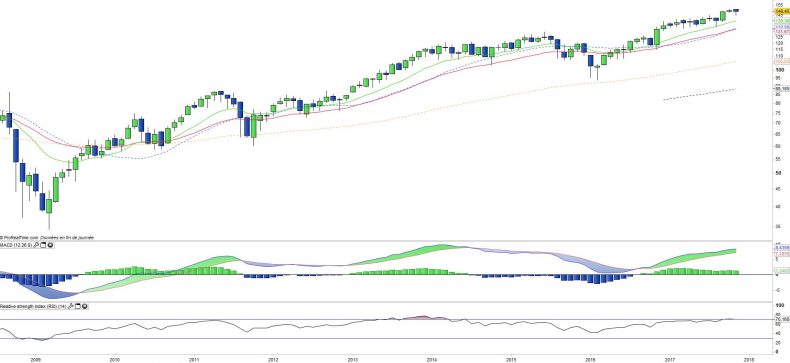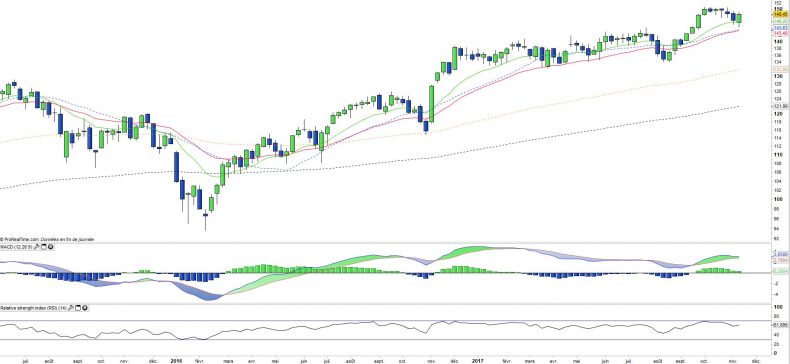iShares US Russell 2000 (IWM) - 20/11/2017
Short Term strategy : Positive (70%) / Trend +
Long Term strategy : Positive (100%) / Trend +
Characteristics of the ETF
The IWM (iShares) ETF replicates the RUSSELL 2000 Index, which is a subset of the Russell 3000 Index of the 3,000 largest US companies representing approximately 98% of the US market capitalization.
The Russell 2000 Index represents only about 10% of the market capitalization of the Russell 3000 and consists of approximately 2,000 small cap companies ($ 2.2bn market cap on average). The Russell 2000 Index seeks to be truly representative of the mid-cap segment, and is fully reconstituted each year to ensure that larger caps do not distort performance and that corporate characteristics actually correspond to the mid-cap segment.
The ETF IWM is currently the benchmark tracker for replicating this US small cap index with fees limited to 0.2% and AUM of $ 42 872M. Replication is direct (physical) and there is a dividend distribution policy on a quarterly basis.
Alternative ETFs: VTWO (Vanguard in USD), RUS2 (Lyxor in USD)
Index & components
The Russell 2000 Index is a very broad index that can be used to profoundly address the US mid caps universe.
The interest of this index is in addition to the high number of components, characterized by the great diversity of the sectors addressed: the financials (c.18%), the technological compartment (c.17%), the industry (c.15). %), health (c.15%) and consumer goods (c.12%) are the main sectors, in a very balanced index which in the end looks very representative of the US economy. However, we can notice that growth themes are more represented, compared to sectors considered as mature, such as energy (3.6%), utilities (3.8%) or telecommunications (0.8%), which are historically heavily represented in the big indices like the Dow Jones for example.
The Russell 2000 valuation multiples are not really higher than those of the large-value indices, with currently a 20x earnings PER at 12 months forward versus 19x for the S & P 500 and 21x for the Nasdaq100. In addition, the companies that make up the Russell 2000 are often companies that are already well structured internationally and therefore in a position to take full advantage of the recovery of the global cycle. These companies, by their average size, are more sensitive to the economic cycle and should therefore record higher growth rates than large companies in the coming months, especially since the margins of large US companies are already at an historical high level.
The small valuation differential with respect to the major indices may therefore appear as an opportunity in that the growth gap could be quite large. The new round of rate hikes will, according to the latest Fed statements, be very gradual and should not pose a short-term threat to US growth in the coming months as the dollar is falling against the Euro and other currencies which should fully benefit medium-sized US companies.
Latest developments
The Russell 2000 has risen 10.2% since the beginning of the year (against 15.2% for the S & P500), after an increase of 21.7% in 2016 (against + 9.5% for the S & P500). The validation of Donald Trump's tax plan by the House of Representatives is good news for the Russell 2000 companies, which reacted positively to the news. An acceleration occurred in the third quarter on the index thanks to a strong catch-up in September (+ 6.3%), but a divergence has since reintroduced with the S & P500 which is up + 2.4% in the current fourth quarter versus 0% for the Russell2000. The markets look carrefully at these divergences, as the Russell2000's downturn or waning trend is often seen as a leading indicator of the fall in the major indices.
The Russell 2000 is considered an "amplifier of the trend". For the moment this divergence is only relative, and can be explained by sectoral biases (energy and health in particular) and the long-term trend seems well installed and confirmed by excellent corporate results in the third quarter. Nevertheless, we will remain attentive to the evolution of the Russel2000 / S & P500 spread
Monthly Data
The monthly chart shows a positive long-term trend that has not wavered since the end of the financial crisis, although the pace of growth is lower this year than the S & P500 and Nasdaq. All indicators are positive and the oscillators are less tight than on large indices even if they are in high zone. After the big bullish candle of September, the current period is a flat consolidation.
The trend is healthy and steady with very low volatility and is not at all challenged at this stage.
Weekly data
On the weekly chart, the oscillations are naturally more marked. We note that the corrections tend to stop on EMA13 or 26, even until the EMA100 level for the most important of them. The current period is characterized by a bullish recovery after a limited correction of several weeks.
A new impulse with the reach of new highs is expected soon.
ETF objective
IWM is an ETF which replicates the Russell2000 index, composed of 2000 small-capitalization US Equities.
Characteristics
| Inception date | 22/05/2000 |
| Expense ratio | 0,19% |
| Issuer | iShares |
| Benchmark |
Russell2000 index
|
| Code/Ticker | IWM |
| ISIN | US4642876555 |
| UCITS | No |
| EU-SD status | Yes |
| Currency | Dollar |
| Exchange | NYSE |
| Assets Under Management | 42 872 M$ |
| Currency risk | No |
| Number of Holdings | 1 984 |
| Risk | 3/5 |
Country breakdown
| USA | 100% |
Sector breakdown
| Financials | 18% |
| Information technology | 17% |
| Industrials | 15% |
| Health Care | 15% |
| Consumer discretionary | 12% |
| Real Estate | 7% |
| Materials | 4% |
| Others | 11% |
Top Ten Holdings
| Bluebird Bio | 0,4% |
| Exact Sciences | 0,3% |
| Nektar Therapeutics | 0,3% |
| MKS Instruments | 0,3% |
| Grubhub | 0,3% |
| MGIC Investment | 0,3% |
| Curtiss Wright | 0,3% |
| Epam Systems | 0,3% |
| Sterling Ban | 0,3% |
| Aspen Technology | 0,3% |
[/groups_member]


